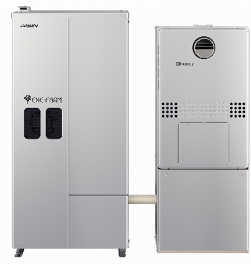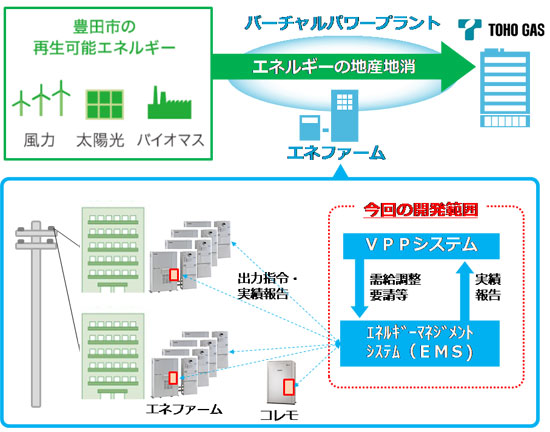Contribution to low-carbon and decarbonized society through energy products
AISIN SEIKI Co.,Ltd.
Outline
We will establish an energy related system that helps realize a low-carbon and decarbonizing society, placing our energy equipment at the core of this.
In particular, we will strive to decrease the price and size of residential combined heat and power (CHP) systems and gas engine heat pumps (GHP) and increase their efficiency, thereby helping to spread their use. With such efforts, we aim to promote energy saving at residential and in business fields, and help accelerate the process of decarbonization.
Furthermore, we will help contribute to the introduction of a greater amount of renewable energy resources onto the power grid. To this end, we promote Internet of Things (IoT) for the products described above, with the aim of using them as a virtual power plant (VPP) resource. This, we believe, will help absorb the fluctuations in the power output from renewable energy resources, while decreasing the need to invest in strengthening infrastructure such as power grid. Moreover, we will strive to realize regional microgrid that enable the effective use of energies in the area by accommodating the energy needs throughout the region through cooperation with other energy resources, including renewable energy sources, electric vehicles (EVs), and rechargeable batteries. Through these efforts, we aim to help create low-carbon, decarbonizing communities.
By establishing regional microgrid, we will secure an autonomous supply of electricity during large-scale power outages, thus enhancing resilience against natural disasters.
Description
【Fields of Energy Efficiency and Hydrogen】
・Regarding residential Fuel Cell CHP system, we aim to reduce the price of SOFCs to one million yen per unit, which is indicated as an objective in the Strategic Roadmap for Hydrogen and Fuel Cells, formulated by the Ministry of Economy, Trade and Industry, to contribute the achievement of the national goal of 5.3 million units in use by 2030. Meanwhile, we also aim to enhance power generation efficiency to over 55% by around 2025, and to over 65% in the future. This will, by around 2030, decrease the number of years needed to recover the initial cost to about five years.
Furthermore, we will strive to downsize the units and eliminate installation disincentives to improve installation flexibility, thereby enlarging a new market targeting small houses and apartments in urban areas.
To this end, we will promote technological development to increase the efficiency and power density of the cell stack in cooperation with cell stack manufacturers.
Moreover, we will accelerate the development of a pure hydrogen fuel cell CHP system which uses CO2-free hydrogen as its fuel, based on the assumption that the establishment of international hydrogen supply chain and enlargement of Power to Gas (P2G) business by increasing renewable energy resources in Japan after 2030.
・Regarding GHP, we will further improve efficiency to contribute to energy saving in the air conditioning demand. We will also improve the GHP for the use of hydrogen fuel in future years.
【Renewable Energy】
・By promoting the Internet of Things (IoT) for our energy product, we aim to establish a remote control system and utilize it as a virtual power plant (VPP) resource. In particular, when 5.3 million residential Fuel Cell CHP systems are actually installed, they can possibly provide a regulated power supply of several million kW. This indicates that they have sufficient potential as a means to absorb the fluctuations in the power output from renewable energy sources. Accordingly, our efforts can help introduce more renewable energy resources without making excessive investment in infrastructure such as power grid. Having participated in the Toyota City Connected Society Verification Promotion Council since fiscal 2018, we have verified that our Fuel Cell and gas engine CHP systems for residential use can be utilized as a VPP resource. We are determined to continue to improve their potential as a VPP resource.
・Regarding GHP, we have already developed a hybrid model that incorporates both a gas and electric heat pump. By using such a product as a VPP resource, we can adjust electricity demand without substantially impairing air-conditioning comfort. Accordingly, by promoting the use of such a product as a VPP resource in the commercial and industrial sectors, we will help introduce a greater amount of renewable energy resources.
・Regarding residential gas engine CHP systems, we have been developing a system incorporating a device that produces biogas using food waste and livestock dung. We have been investigating its usability by conducting verification experiments not only in Japan but also in Bangladesh and India.
・Using the product and systems described above, we will strive to realize regional microgrid that enable the effective use of energies in the area by accommodating the energy demand throughout the region through cooperation with other energy resources, including renewable energy sources, EVs, and rechargeable batteries. Through these efforts, we aim to help create low-carbon, decarbonizing communities.
【Others: resilience】
・Equipped with an autonomous operation function for generating electricity during power outages, residential CHP systems can supply electricity and hot water even during the power outages caused by natural disasters. This function helps guarantee a minimum quality of life even when a disaster occurred.
・When electricity and gas infrastructure is damaged by an earthquake or other natural disaster, energy vehicles equipped with a residential gas engine CHP system can visit affected areas to provide assistance. Such vehicles can support the daily life of the local residents until the infrastructure can be restored in the area, increasing resilience against disasters.
Supplementary information
【ENEFARM type-S, 2020 model】
https://www.aisin.co.jp/news/2020/012157.html
【Virtual Power Plant Verification Project】
https://www.aisin.co.jp/news/2019/011964.html
【Energy Vehicle】 *Winning Good Design Award
https://www.aisin.co.jp/news/2019/012050.html
Similar Innovation Challenges
Accelarating the penetration of renewable energy resources with “Open Energy System”
Sony Group Corporation
Achieving net-zero carbon emissions from plant factories using full artificial lighting
Taikisha Ltd.
Advanced technology for buildings providing energy-saving and comfortable indoor environment (under Net Zero Energy condition)
Mitsubishi Electric Corporation
AI control reduces base station power consumption by up to 50%
KDDI CORPORATION









